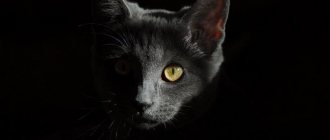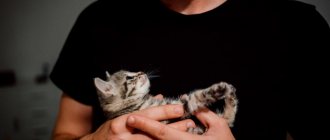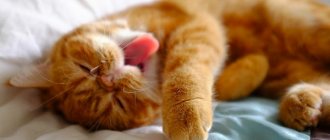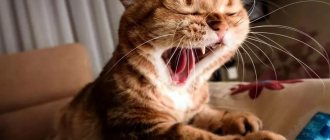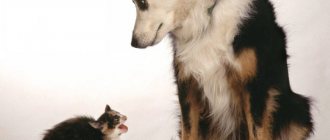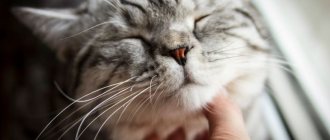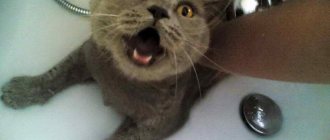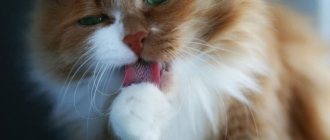The cats of Ancient Egypt became famous throughout the world thanks to the respectful attitude of the Egyptians towards these delightful animals. They endowed them with positive human qualities. It was believed that cats have mystical powers and they know what secrets are kept in the other world. Cats witnessed religious ceremonies. They protected their owners and homes from evil spirits.
This is what is written on one of the pedestals in the Valley of the Kings:
“You, Great Cat, are the embodiment of justice, the patron of leaders and the holy spirit. You are truly a Great Cat."
The high role of animals in Egyptian society is declared by the fact that the main industry in the state was farming. This meant that there was a constant need to combat infestations of mice, rats and snakes. Apparently, the Egyptians learned that cats could hunt uninvited guests and specially planted food for them so that they would come to warehouses and fields more often.
All this happened near populated areas, so the cats gradually began to get used to people and began to live with them. Kittens began to appear in a safe shelter - a human house. Cats were used to interpret dreams. They could predict whether the harvest would be good.
There was no difference between wild and domestic cats in Egypt. They were all called "miu" or "miut". The origin of these words is unknown, but it is likely that they arose from the sound that animals make - meowing. Even little girls were called this, emphasizing their excellent traits: gentleness of character, cunning and intelligence.
Cats in the history of Ancient Egypt
Cats of Ancient Egypt
In ancient Egypt, there were two breeds of cats. "Junge Cat" and "African Wild Cat". The latter had a calmer character and were domesticated. There is evidence that the entire ancestry of all domestic cats came from Egypt.
It is believed that the first animals were brought to Egypt from Persia around 2000 BC. from Nubia during the New Kingdom. Although in fact this opinion is erroneous, since archaeologists found a man interred with a cat in a mound near Asyut in the south of the country. The burial dates back to around 6000 BC. It is believed that cats were domesticated around 2000 BC. And dogs - approximately 3000 BC.
During the New Kingdom, images of cats can be found in human tombs. Owners often took cats with them on hunts to catch birds and fish. The most common drawings are those where the cat sits under or next to the chair of the owner of the house, which means protection and friendship.
When the city of Bubastis (Per-Bast) was built as a royal residence for Shoshenq I (XXII Dynasty), the cult of the cat Bast was at the center of the administration of the great power.
Herodotus visited Bubastis around 450 BC. and noted that even though the temple of Bast was not as large as in other cities, it was richly decorated and presented an interesting sight.” He also confirmed that the annual Bast festival was held in one of the most popular cities in Egypt.
Hundreds of thousands of pilgrims came from all over Egypt to have fun, drink wine, dance, sing and pray to the cat. The festival was so famous that the prophet Ezekiel warned that “The young men of Aben and Bubastine will fall by the sword, and their cities will be captured” (Ezekiel 30:17, 6th century BC). Bubastine was destroyed by the Persians in 350 BC. The cult of Bast was officially banned by imperial decree in 390 BC.
Egyptian cats
Serval
Representatives of three species of small wild cats are known to have lived in Ancient Egypt.
Wild Libyan, otherwise African or steppe cat ( felis silvestris lybica
) - the most common. A subspecies that can be found in Africa, excluding the Sahara and tropical forests, as well as in the Near and Middle East. Its size ranges from 50 to 70 cm, and its weight is from 3 to 7 kg. In appearance it resembles a short-haired domestic cat, but is distinguished by its larger size and elongated limbs. A predominantly nocturnal animal, hunting at dusk or at night. During the day it hides in holes or under trees, sheltering from the heat.
Jungle cat or house ( felis chaus
) is a small wild cat that lives in wet areas (it can be found in many places as far as Asia). Much larger than the Libyan wild cat, but with shorter legs, its size reaches from 60 to 75 cm, and its weight ranges from 10 to 15 kg. She has a long and thin muzzle, black tufts on her ears. The coat is a thick terracotta color, with black stripes on the paws.
Serval ( felis serval
) is a cat native to Nubia (it can be found from sub-Saharan Africa to South Africa). A predominantly nocturnal animal, it lives in the savannah. The average size is approximately 70 cm, weight ranges from 14 to 18 kg, and has an elevated body on long legs. The coat is covered with wild brown spots, which lighten closer to the belly. She has big ears, a small head and big eyes.
Cult of the cat in ancient Egypt
The most famous cat cult was Bast. There were also several other ancient idols associated with the animal. Nate sometimes took the form of a cat. The cat was one of the sacred symbols of Mut.
The Book of Gates and the Book of Cave indicate that the cat represented a sacred animal called Miuti (Mati). The 11th section of the Duate in the Book of Gates (the pre-dawn hours) is dedicated to her. And the time when Ra fights enemies in the Book of Caves. It is possible that this cult was associated with Mauti, depicted in the tomb of Pharaoh Seti II and refers to Mau or Mau-Aa ("Great Cat") as one of the manifestations of Ra.
In Chapter 17 of the Book of the Dead, Ra takes the form of a cat to kill the snake Apep:
“I, the cat Mai, rushed into the trees of Perse on the night of Anna, when the enemies of Neb-er-tcher” (a form of Osiris) were destroyed!”
Cats were also associated with the "Eye of Ra" and Isis because they were perceived as great mothers.
Common Egyptian names
Interesting male names popular in Egypt:
- Atum is holistic.
- Donkor – quiet, modest.
- Jafari is a trickle.
- Kenti is the head, the leader.
- Nave is an invisible spirit.
- The set is dazzling, bright.
- Tabit is a strong man, a tough guy.
- Holdun - immortality.
- Shenti – fluffy.
- Shushu is a lover of boasting.
- Yahya - bestowed by heaven.
Dear Nef:
Now a selection of euphonious female Egyptian names:
- Azenet – “daddy’s girl”.
- Akana is spherical.
- Aloli – bunches of grapes.
- Ati – soft as a pillow.
- Bahiti – wealth, prosperity.
- Yerby is a princess.
- Ia - lunar.
- Ife - eternal love.
- Kepi - thunderstorm, storm.
- Kebi - honey.
- Kiya is perky and cheerful.
- Cleopatra is the pride of fathers.
- Mesi – flow of water.
- Merit – beloved, beloved.
- Miu – soft, tender.
- Monifa – lucky, fortunate.
- Nebi is the name of a panther.
- Nanu is a beauty.
Kitty Nebi:
- Nubit is noble. "golden" lady.
- Razia – pleasant looking.
- Rashida - truth, justice.
- Rehema – sympathetic, compassionate.
- Sajira is small.
- Salama – calm, peaceful.
- Sanera is a small kitten.
- Tabia – having abilities, talents.
- Unique – radiance.
- Chizizi is a mystery, a mystery.
Kitten named Unika:
Killing a cat in ancient Egypt
Mummy of a cat in Ancient Egypt
Many animals, especially in the early period of civilization, were assigned magical powers, such as crocodiles, hawks and cows. Each cat was connected with the other world and protected the common man as he entered the Kingdom of the Dead. Only the pharaoh was considered so powerful that all animals were under his care.
Very high fines were levied for harming her throughout Egyptian history.
During the popularity of the Bast cult, killing a cat was punishable by execution.
Diodorus Siculus wrote:
“Whoever kills a cat in Egypt will be sentenced to death, whether he committed this crime intentionally or accidentally. People are going to kill him. Unhappy Roman, he accidentally killed a cat, but his life cannot be saved. This is what King Ptolemy of Egypt commanded.”
However, studies of cat mummies suggest that they were either injured or deliberately killed at Bubastis.
The smuggling industry of illegally exporting cats to the center of the country flourished. Court records confirm that the pharaoh's army was sent to rescue the stolen animals.
Herodotus claimed that when there was a fire in the house, the cats were taken out first. This was explained by the fact that cats, frightened by the sight of a stranger, can “jump into the fire.” This story may be exaggerated, but it highlights the animal's high status in Egyptian society.
The philosopher tells a story about the Egyptians' love for cats. Apparently, the Persians captured several families of cats and took them outside of Pelusia. When the Egyptian troops saw the frightened cats on the battlefield, they surrendered, helping out their loyal friends.
Egyptian Mau - cat of the pharaohs
Increase
Much that is connected with the history of Ancient Egypt is still shrouded in mystery: mysterious pyramids, powerful pharaohs, tomb treasures, sphinxes, the sands of time... No less mysterious is the breed of cats of the pharaohs “Egyptian Mau”, or, as some sources also call it - Egyptian Mau. The walls of the ancient pyramids of Egypt are decorated with images of cats of this particular breed (and “mau” is translated as “cat”). In general, cats were sacred animals in Egypt.
Cats in Ancient Egypt
The first written mentions of Egyptian Mau cats date back to the fifth century BC, and the author of these mentions is the ancient Greek historian Herodotus (he actually told the world a lot about them). Herodotus reports that as early as three thousand years BC, every Egyptian kept a cat in his house. True, Herodotus does not tell what they were like.
The very fact of the large number of domestic cats in Ancient Egypt is not surprising. After all, it is known that cats were valued and respected there. The Egyptians treated these sacred animals with divine reverence. The temples contained numerous statues of the goddess Bast and the cat Bastet. And the supreme god Ra was often depicted as the Great Cat. Images of a red cat (the Sun god) cutting off the head of a serpent with a knife have survived to this day. And the original appearance of the Sun in Egyptian mythology is a cheetah (also a cat).
Even the death of ordinary domestic cats was accompanied by a sacred ritual. When the cat died, it was mummified. Cat mummies were placed in gold and silver sarcophagi encrusted with precious stones. During archaeological excavations in the city of Beni Hasana, an entire cat cemetery was discovered with the burials of one hundred and eighty thousand (!) cat mummies. It is also known that owners, as a sign of grief for a deceased cat, shaved off their eyebrows and wore many days of mourning.
History of the breed
The exotic cat Egyptian Mau traces its long pedigree back to the cats of the great pharaohs. This is a very ancient breed, formed as a result of natural selection. The appearance of Mau cats has undergone virtually no noticeable changes in more than three thousand years. For a very, very long time, this ancient breed was preserved only in its homeland. And the modern history of the pharaoh cat breed began a hundred years ago.
Important!
Doctors have discovered a new cause of bad breath: parasite infection.
European cat breeders decided to recreate the Egyptian Mau breed. But the first results of recreating the breed were “negated” during the Second World War. The second attempt, which ended in success, was made in the fifties by the Russian princess Natalia Trubetskoy, who lived in Italy. The princess was the owner of two Mau cats (Gepa and Ludol), brought from Egypt. Trubetskoy registered them with the FIFe association, and after immigrating to the United States, she founded the Fatima nursery. As a result of long and painstaking work by American felinologists, the Egyptian Mau was recognized by the CFA as an official breed in 1977.
These cats were brought to Europe in 1988, but they first came to Russia only in the summer of 2010. They were purchased by Polina Gorelkina, owner of the nursery “EgyptSila” (Egyptian Strength).
Features of the appearance of the pharaoh cat
Egyptian Mau - miniature leopard. By the way, that’s what they call it: a leopard for the living room. But dark spots are not the only marks on the fur coat. A distinctive feature of these cats is their bracelets and necklaces. The necklaces are contrasting stripes around the neck, and the bracelets are half rings on the top of the front legs. In addition, the real pharaoh's cat is marked with the sign of a scarab. This is a dark design in the form of the letter W, located at ear level, connected to the “letter” M above the eyes.
And the eyes... The eyes of Egyptian cats are exclusively green, large and almond-shaped. Like true Egyptians of Ancient Egypt, Pharaoh cats have “goddess makeup”: two long arrows that emphasize the eyes and run along the cheekbones to the temples.
Another unusual feature of the appearance of Egyptian Mau cats is the small folds-bags in front of the hind legs. It is generally accepted that these folds hanging under the belly are needed for the swing of the hind legs when running fast and jumping high.
Breed standard
The Egyptian Mau is a type of cat that resembles the Abyssinian. The CFA standard imposes the following requirements for the breed.
The build is strong and muscular, with well-developed bones
The ears are set high and wide, medium or large in size, sharp at the ends, sometimes with tassels.
The eyes are almond-shaped, large, and gooseberry-green in color, located slightly obliquely towards the ears.
The coat is short or medium length, shiny, thick and silky.
Three types of color: silver, bronze, smoky.
Markings: dark spots, scarab mark, “oriental makeup”.
Disqualifying features of the Egyptian Mau breed: lack of characteristic markings, yellow eye color.
Pharaoh cat character
The Egyptian Mau is special not only for its pedigree and striking appearance. She is also characterized by distinctive (sometimes contradictory) character qualities. For example, cats of this breed are both independent and devoted to their owners, balanced and passionate.
Mau cats are very energetic. They love walks and even agree to wear a collar or harness for this purpose. They are active and flexible, playful and sociable, and cannot stand loneliness. They have a melodic and expressive voice, by which you can always recognize the emotions and mood of the animal.
Like all Mau cats, they are not without the desire to take a sweet nap after dinner or to cuddle on their owner’s lap. At the same time, they are unobtrusive and always feel whether a person is inclined to such communication or not. When there is an excess of joyful emotions, cats jump on their front (!) legs, wagging their tail so quickly that it simply cannot be seen.
Cat care
Like all pets, Egyptian Mau cats require attention and care from the owner. And above all, her wonderful coat needs care. Even just petting these cats is beneficial, not to mention the fact that they need constant brushing: both help remove dead hair. For daily combing, you need a special fine-toothed comb, and for periodic, more intensive combing, a rubber brush. In addition, it is also useful to polish the wool with a soft chamois, nylon or silk scarf.
Hygiene procedures include removing excess ear secretions, trimming claws and bathing the animal as necessary. You should also monitor the condition of the teeth, and the health of the cat in general.
Curious facts
During heat, cats can make such loud noises that it is impossible to hear the other person.
According to breeding rules and breed standards, Mau cannot be crossed with cats of other breeds.
Mau are the fastest of all cats: they can reach speeds of almost 60 km/h.
Mau carry their cubs much longer than other cats: pregnancy lasts up to seventy-three days.
They tend to overeat and may become obese.
The Egyptian Mau is a cat breed that is still very small in number, and therefore still rare and expensive. Mostly representatives of this breed live in the United States, but there is also a Mau nursery in Europe (Germany, Italy, Holland, France). In Russia, there is so far only one single Egyptian Mau nursery, which is located in the Moscow region and is called “Egyptian Power”. Therefore, it is quite difficult to acquire this rare cat, but, according to true connoisseurs of the breed, such a cat is worth the money spent on it.
Source
Share
The process of mummification and burial of cats in Egypt
When the cat died, the owner's family went into deep mourning and shaved their eyebrows. The cat's body was mummified and buried, setting up a warehouse with mice, rats and milk. Some graves have been discovered in Bubastis, Giza, Dendera, Beni Hassan and Abydos. In 1888, a cat necropolis with 80 thousand cat mummies was found in Beni Hassan.
The cat's body was embalmed. Diodorus wrote:
“Treated with cedar oil and spices to impart a pleasant scent and preserve the body for a long time.”
Egyptian nicknames for cats
Cats are independent and calm animals. Unlike cats, they have a more solid and direct character, like the wise gods and rulers of Egypt.
Egyptian names for boys cats in honor of the gods:
- Aikhi - god of music;
- Aker - god of the underworld;
- Amon is the patron of the sun;
- Ha - God of the desert;
- Anubis - god of the kingdom of the dead;
- Apis - god of fertility;
- Horus - sun god;
- Ihi - god of music;
- Montu - god of war;
- Nepri - god of grain;
- Nefertum - god of vegetation;
- Onuris - god of hunting and war;
- Osiris - god of rebirth;
- Ptah is the creator;
- Set - god of storms and deserts;
- Thoth is the god of wisdom;
- Shesemu is the patron saint of winemaking;
- Shu - god of air;
- Shai is the patron saint of man;
- Jah is the god of the moon.
Cats and Egyptian gods
The goddess Bast or Bastet - the daughter of the sun god Ra, the wife of the god Ptah and the mother of the lion-headed god Maahes - was depicted as a woman with the head of a cat. She was the patroness of women, children and all domestic animals. Bast was also considered a goddess who protected against infectious diseases and evil spirits. It was she who was revered by the Egyptians as a goddess of fertility. Bast was often depicted with a rattle, this was due to the fact that cats, who gave birth often and in large numbers, as well as tenderly caring for their offspring, were symbols of motherhood.
Women who asked the goddess Bast for children wore amulets with images of kittens. The number of kittens per decoration was equal to how many children they wanted to have.
Also, ancient Egyptian cats were considered “the eyes of the god Ra.” This high title was apparently given to them in connection with the peculiarity of the cat’s pupils - in the light they narrow, becoming like a moon, and in the dark they expand, becoming round like the sun. This is exactly how the Egyptians imagined the two eyes of Ra - one solar, the other lunar.

